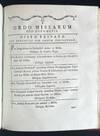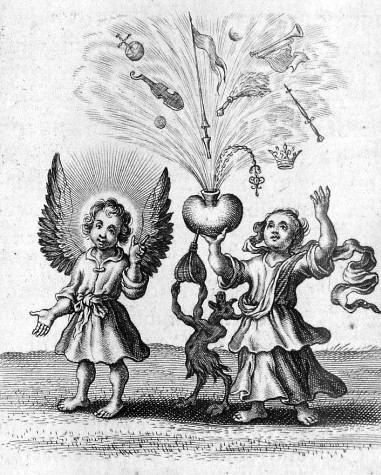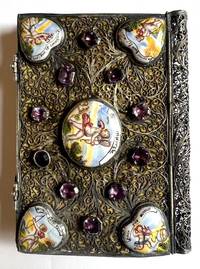1777 · Prague
by BOHEMIAN LITURGICAL CALENDAR
Prague: Joannes Carolus Hraba, 1777. 4to (238 x 192 mm). [84] pages. Interleaved. Woodcut head- and tail-pieces and typographic ornaments. Contemporary Bohemian gold-tooled red morocco, covers with double decorative borders including drawer handle and flower tools, the two borders linked at the corners by flower tools, at center the gold-blocked arms of Count Emmanuel Ernst von Waldstein, Bishop of Litomerice within a wreath, spine gold-tooled in six compartments, Hernnhuter(?) pastepaper endleaves with a recessed saltire design of floral bands on a purple-gray ground, at center of each compartment a wreath-like ornament in green with a red center, gilt edges (extremities worn, covers a bit scratched, endpapers faded at outer edges). Provenance: Emmanuel Ernst von Waldstein, Imperial Count, Bishop of Litomerice (1716-1789), supralibros; early inscription on title, Unica spes nostra Deus est; William A. Foyle (1885-1963), bookplate, sale, Christie’s London, 11 July 2000, part lot 142.***
A lovely and rare example of liturgical printing and Bohemian bookbinding, this interleaved volume of the annual guide to daily liturgy of the cathedral of Litomerice or Leitmeritz, a town on the river Elbe, halfway between Dresden and Prague, and the seat of the eponymous diocese, belonged to the Bishop under whose authority it was issued.
The Directorium (or Ordo recitandi, or Calendarium) was printed each year for the use of all the clergy in a diocese. “It consists simply of a calendar for the year, in which there are printed against each day concise directions concerning the Office and Mass to be said on that day. The calendar is usually provided with some indication of fast days, special indulgences, days of devotion, and other items of information which it may be convenient for the clergy to be reminded of as they occur. This Ordo is issued with the authority of the bishop or bishops concerned, and is binding upon the clergy under their jurisdiction” (Catholic Encyclopedia).
Following the calendar are several sections of an Ordo missarum listing a total of 43 deceased local individuals for whom private Masses are to be held, the frequency per year evidently depending on how much their families had paid. The volume concludes with the Ordo processionis, for processions to be held either at the public’s request or in times of drought, when rain is sought (apparently a frequent occurrence!).
Emmanuel Ernst von Waldstein, a member of the prominent Bohemian noble family, served as auxiliary bishop of Prague before becoming the 6th Bishop of Litomerice in 1759. In line with the enlightened domestic policies of Holy Roman Emperor Joseph II, Waldstein was a patron of the arts and sciences who promoted education among the clergy, scholarship and culture. He formed his own private library and numismatic collection, both still preserved, and is remembered for his tolerance.
The distinctive pastepaper endleaves of this volume may have been produced by the Moravian nuns of the convent of Herrnhut, a town at the eastern edge of Saxony, due east of Dresden (and 93 km northeast of Litom ice). From about 1765 to 1824 these sisters produced delightful pastepapers (Kleisterpapier), using dyes from discarded textiles, which they decorated with their fingers, with small wooden stamps to produce a negative or white design, and/or with small wheeled rolls. The criss-crossing decorative bands of this example were apparently produced by repeated rectangular woodblocks or short rolls. “The creativity of these papers, their variety and artistic quality were immediately appreciated.... Sold by traveling peddlers, they rapidly penetrated all the regions of Germany and neighboring countries. These papers are today considered among the most accomplished of all pastepapers” (Kopylov, my translation).
I locate no other copies of this Directorium. On the paper, see: Christiane Kopylov, Papiers Dorés d’Allemagne (2012), p. 26 and nos. 182-185; Haemmerle, Buntpapier (1977), pp. 139-144; Heijbroek & Greven, Sierpapier (1994), pp. 30-32. (Inventory #: 4424)
A lovely and rare example of liturgical printing and Bohemian bookbinding, this interleaved volume of the annual guide to daily liturgy of the cathedral of Litomerice or Leitmeritz, a town on the river Elbe, halfway between Dresden and Prague, and the seat of the eponymous diocese, belonged to the Bishop under whose authority it was issued.
The Directorium (or Ordo recitandi, or Calendarium) was printed each year for the use of all the clergy in a diocese. “It consists simply of a calendar for the year, in which there are printed against each day concise directions concerning the Office and Mass to be said on that day. The calendar is usually provided with some indication of fast days, special indulgences, days of devotion, and other items of information which it may be convenient for the clergy to be reminded of as they occur. This Ordo is issued with the authority of the bishop or bishops concerned, and is binding upon the clergy under their jurisdiction” (Catholic Encyclopedia).
Following the calendar are several sections of an Ordo missarum listing a total of 43 deceased local individuals for whom private Masses are to be held, the frequency per year evidently depending on how much their families had paid. The volume concludes with the Ordo processionis, for processions to be held either at the public’s request or in times of drought, when rain is sought (apparently a frequent occurrence!).
Emmanuel Ernst von Waldstein, a member of the prominent Bohemian noble family, served as auxiliary bishop of Prague before becoming the 6th Bishop of Litomerice in 1759. In line with the enlightened domestic policies of Holy Roman Emperor Joseph II, Waldstein was a patron of the arts and sciences who promoted education among the clergy, scholarship and culture. He formed his own private library and numismatic collection, both still preserved, and is remembered for his tolerance.
The distinctive pastepaper endleaves of this volume may have been produced by the Moravian nuns of the convent of Herrnhut, a town at the eastern edge of Saxony, due east of Dresden (and 93 km northeast of Litom ice). From about 1765 to 1824 these sisters produced delightful pastepapers (Kleisterpapier), using dyes from discarded textiles, which they decorated with their fingers, with small wooden stamps to produce a negative or white design, and/or with small wheeled rolls. The criss-crossing decorative bands of this example were apparently produced by repeated rectangular woodblocks or short rolls. “The creativity of these papers, their variety and artistic quality were immediately appreciated.... Sold by traveling peddlers, they rapidly penetrated all the regions of Germany and neighboring countries. These papers are today considered among the most accomplished of all pastepapers” (Kopylov, my translation).
I locate no other copies of this Directorium. On the paper, see: Christiane Kopylov, Papiers Dorés d’Allemagne (2012), p. 26 and nos. 182-185; Haemmerle, Buntpapier (1977), pp. 139-144; Heijbroek & Greven, Sierpapier (1994), pp. 30-32. (Inventory #: 4424)








![[Incipit:] A la muy Esclarecida Señora, mi Señora la Señora, Doña Isabel Salzedo Azcona, Rio, &c. Condesa de Gomara, &c., dignissima esposa del Señor D. Manuel Villavicencio ... Marques de Alcantara, del Cuerbo, &c. Señora, aun no perfectamente deliberado a presidir este primero publico rasgo de mi corto ingenio in este Celeste Theatro de Salamanca …](https://d3525k1ryd2155.cloudfront.net/h/650/712/1676712650.0.m.jpg)
